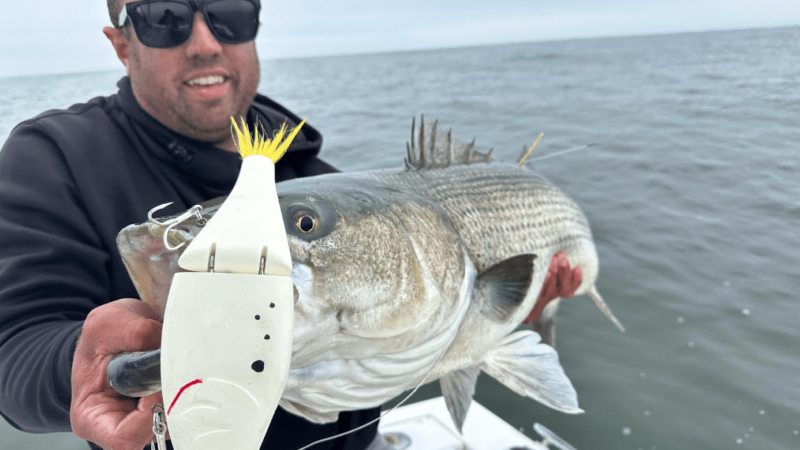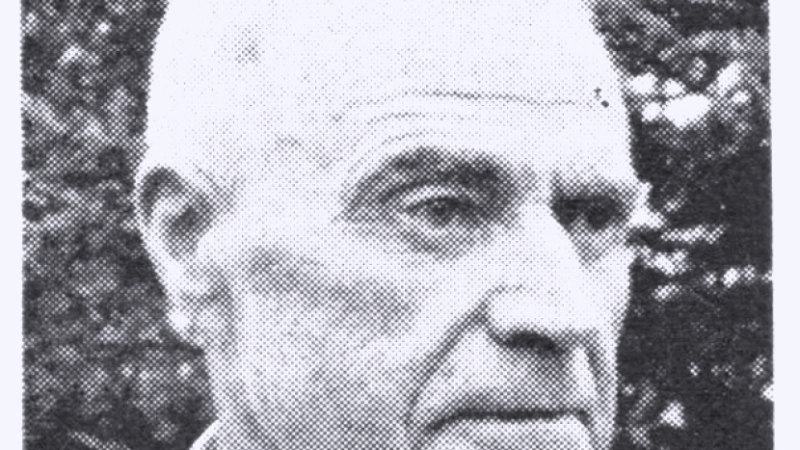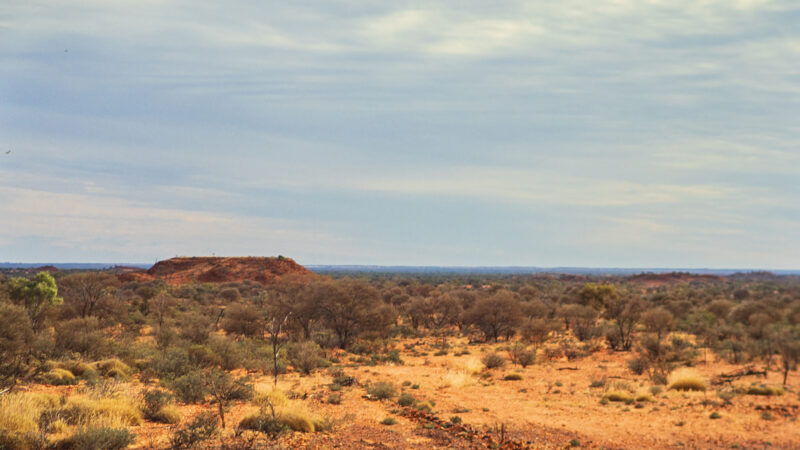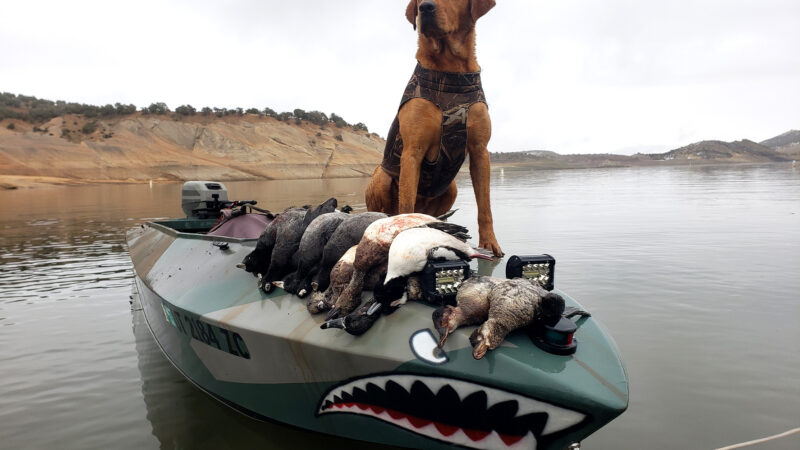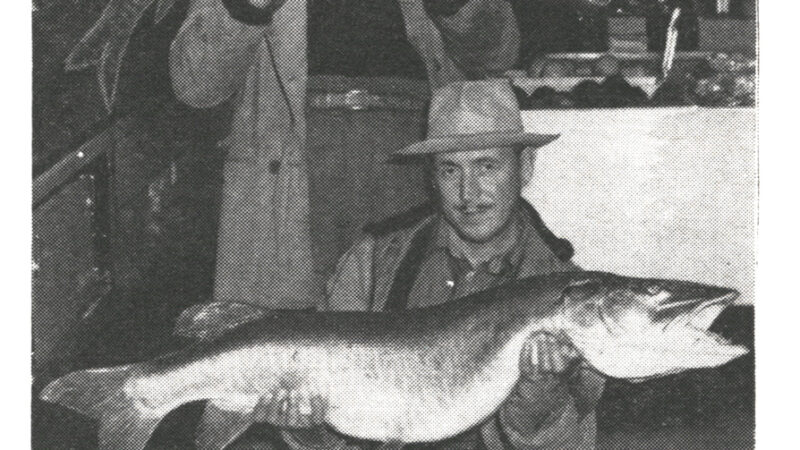The Game Warden Asked Us to Track One Lion. We Found Four in Two Days
This story, “Four Lions,” appeared in the August 1956 issue of Outdoor Life. The $75 bounty per hide mentioned in this story is the equivalent of about $1,015 today.
On a cold January morning in 1948 Boyd McCracken, our local game warden, parked his pickup truck at the end of a gravel road half a mile from Maxfield Creek and walked into the timber to count elk.
Snow had fallen in the night, and before Boyd had walked far he hit the fresh track of a cougar, following a band of elk. In McCracken’s book that spelled trouble, so he hurried back to the road and drove to my home in the little town of Forks, on the Olympic Peninsula in northwestern Washington, to ask me and my hunting partner, Charlie Crawford, to bring our dogs and try for the lion.
He didn’t have to ask twice. I declared my own private war on cougars a long time ago. Everyone I ever followed was a killer, ranging in big circles and knocking off as many as eight or 10 deer and elk in a week.
I started back in 1916, the second year after I came out to Washington from my boyhood home in the southern Michigan town of Napoleon. I was running a packtrain for surveyors and timber cruisers at the time, and my cougar hunting was limited to week-ends and holidays. My kill wasn’t impressive, for lions weren’t too plentiful in the Olympic country then, but I had fun.
In 1938 some 900,000 acres of rugged mountain wilderness went into the Olympic National Park, and all that area was closed to hunting. As a result the population of game animals and predators alike has expanded, arid in recent years the cougars have been spilling over the park boundaries, coming down into the densely wooded river bottoms to prey on elk and deer. They kept getting more and more plentiful and presenting a bigger and bigger temptation, so in 1945 I acquired a pair of top-notch lion dogs and went about cougar hunting in earnest. Charlie Crawford teamed up with me a year later and we’ve been at it ever since, as often as we get the chance.
I’ve bagged 64 cougars, all told. My best score was 16 in a year. One winter Charlie and I accounted for eight in 33 days. In addition, we’ve claimed bounty on about 300 wildcats. That many cats, big and little, have taught us a lot and furnished us our share of lively action.
So Charlie and I couldn’t have had better news that January morning than the word McCracken brought us. In 15 minutes we had our dogs loaded into my pick-up and were headed for Maxfield Creek, with the game warden leading the way.
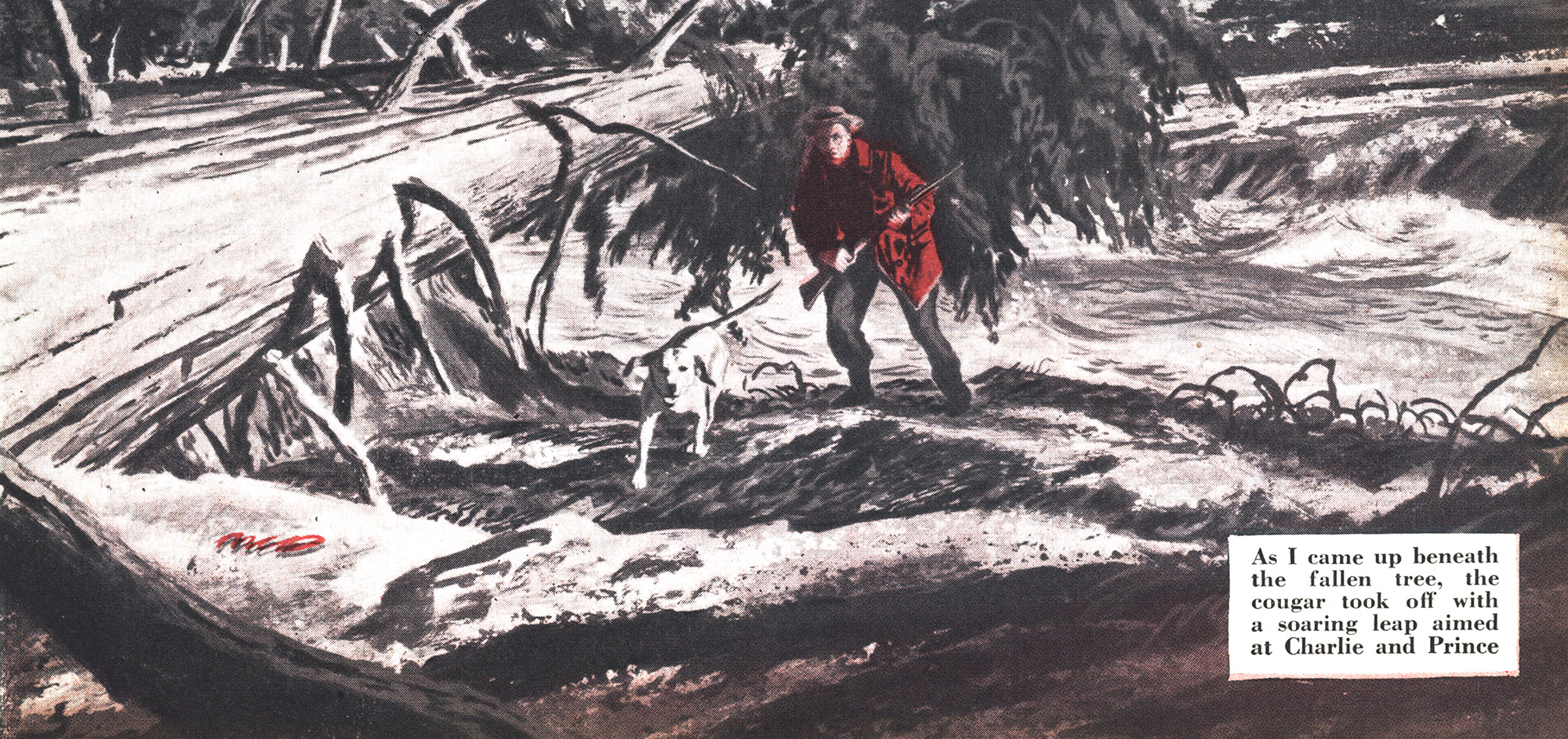
We had three dogs that winter. Each of us owned one privately; the third was joint property, with neither wanting to claim him outright. Mine was a female named Lu, black and tan and bluetick, with the bluetick blood dhowing. Charlie’s Prince was from the same litter. Our partnership dog, Jim, was an ornery crossbred mixture of Walker, redbone, and collie, quarrelsome with the other hounds and mean to handle, but one of the best tree dogs we ever used. That was the only reason we put up with him.
Maxfield Creek drains a wild and rugged chunk of country, running into the Bogachiel River about four miles above the Pacific. Boyd had found the cougar sign some 12 miles west of Forks. We crossed the lower Bogachiel on a swinging bridge, parked the two pick-ups at the end of the gravel road, and headed into heavy timber afoot. Within half an hour we cut the cat track on the side of a steep ridge.
It had been made toward daylight and the dogs hit it wide open, heading north through one of the roughest and wildest areas in Washington. The three of us lit out after them and managed to keep them within hearing for half a mile. Then they split up. Lu and Jim made a sharp turn to the west and went out of hearing in that direction. The last we heard of Prince he was still running due north, shouting word of a fresh track every foot of the way.
We came to the place where they’d divided, but the timber was thick and there wasn’t enough snow on the ground for us to piece the story together. It was a safe bet we had two cougars going, however, and we decided to follow Prince. From the way he sounded we wouldn’t have far to go. The mountain lion is notoriously short-winded. Pressed by a fast, fresh dog, he’s likely to make a very short run. On top of that, we knew we could pick up Jim and Lu on the way back to the road. “If they don’t chase that cougar out into the ocean,” Charlie added with a chuckle.
It was 30 minutes before we heard anything more from Prince, and then, close to a mile ahead, we heard him barking treed. We hadn’t been loafing up to that time, but now we really hurried, for Prince was a young dog and likely to get discouraged and leave the treed cat if nobody gave him a hand. But he stuck with it. We found him down in thick undergrowth at the bottom of a canyon, barking under a small spruce. About 20 feet up the cougar was crouched in a fork, glaring down at the dog and occasionally cutting loose with a spitting growl — which was just the encouragement Prince needed.
At that time I carried a Remington pump .22 Special on my cougar hunts. You don’t need a heavy caliber for cats, since you can count on a stationary target at close range and put the bullet exactly where you want it. You can’t always kill a cougar stone-dead with one shot, of course, but if you smack a .22 into his head he won’t live long.
One precaution we always take, however. Before the shooting starts we tie the dogs. Otherwise they pile into the cat the instant he hits the ground, and even a dying cougar can kill a dog with one swipe. We lost one good one that way, killed so quick he didn’t have time to howl, and we no longer take chances. Charlie caught Prince and got a rope on him. I handed the rifle to Warden McCracken but he passed it back.
“Your dogs, your shot,” he insisted.
At 20 feet it was like shooting a can off a post. I put the little soft-point bullet between his eyes and he was dead when he left the tree.
With wildcats we allow our dogs the fun of inspecting the carcass, once we’re sure the cat is completely out of commission; but not with cougars. A cougar pelt is worth $10 or more — if it hasn’t been worked over by a cat-hating hound.
This lion was a youngster, six feet six from tip to tip and weighing only about 75 pounds. We hefted him and voted to get him to Forks in one piece and skin him there.
Taking turns shouldering the cat, we hiked back to where we’d last heard Lu and Jim. They were still out of hearing, so we went on to the road and got rid of our cougar. It was now 3:30 p.m. and McCracken had to head for home. Crawford and I would try to pick up the other two dogs.
A couple of miles to the west of our original parking place we drove in on another dead-end road and stopped to listen. From away off to the north came a throbbing, broken drumbeat of sound — Jim’s deep voice, and the high, clear belling of Lu. They were barking treed. No need to hurry this time. Jim had plenty of faults, but quitting the tree was never one of them, and as long as he stayed Lu wouldn’t leave.
We turned Prince loose, and he ran toward the distant baying like greased lightning. Charlie and I followed as fast as we could — through a dense swamp where shell ice broke under Charlie and dumped him into mud and water above his knees, then up a steep ridge with sweat streaming off us. It was close to dark when we finally got up to the dogs. They were raging around a big hemlock that had fallen so that its top stuck out over a shallow ravine like a diving board.
The cougar had taken refuge among the branches at the far end and the dogs were hazing her, crazy with excitement. They’d charge out on the fallen tree until they were 20 or 30 feet from the cougar. Then she’d rush them, snarling and spitting, and the dogs would change ends and all but knock one another off the log getting back to the base of the tree. The cat would retreat, growling and lashing her tail, and the instant she was back among the branches the dogs would be after her again.
But we didn’t have time to watch this show. Shadows were falling in the timber and we’d have to move fast if we meant to kill the cougar before it was too dark to shoot.
Charlie caught and tied Prince. After leaning the rifle against a stump, I slipped out of the packsack I always cany on such hunts and fumbled past the first-aid kit, emergency rations, candles, matches, extra shells, and other gear to get my dog ropes. I fished them out and started for Lu and Jim. I could have caught Lu without any trouble, but not Jim. He saw me coming and, cantankerous and stubborn as always, evaded me by jumping down the bank. I called him back but he paid no attention. He was directly under the cougar now, baying and fretting, and he liked it down there.
I didn’t waste any more time with the ropes. If the dog wanted to play it that way he could take his own chances. I picked up the rifle and slid down the bank to join him. The two of us were under the cougar now, only a few yards away, with Charlie and the other dogs still up on the bank.
That was too much for the lion. Before I could shoot, she was dashing down the trunk, spitting and snarling. Lu was in the way but the cat jumped clear over her. I can see that leap yet, the cougar’s legs spread out like a flying squirrel’s, her long, black-tipped tail streaming behind for balance.
She almost landed on top of Crawford. He jumped back to get out of the way and half lost his footing. Prince jerked the rope out of his hand and spurted after the cougar, along with the two other loco dogs. They were breathing down her neck and making the woods ring with their baying. Dragging his leash through tangled undergrowth, Prince was in about as dangerous a situation as a dog can get into. If the cougar made a long run, there was a chance he’d hang himself on a snag and be dead before we got to him.
But the cat never had a chance for long run. The dogs crowded her up tree 100 yards down the ridge.
We hurried down, and I worked around on the uphill side for a shot. I was almost on a level with the cougar there and only 30 yards away, but by now it was so dark I could see only a shadowy shape among the branches. There was no telling head from tail and no hope of picking a vital spot for a target. And in another five minutes it would be too dark to shoot at all. Well, the dogs would have to look out for themselves this time. I lined my sights on the middle of the dark form and smashed a shot at it.
The cougar came out of the tree in a soaring 25-foot leap and made an amazing landing in the top of another tree farther downhill.
I slid and scrambled down for another try. By this time Charlie had managed to grab the rope Prince was trailing and take him out of the fracas. But Jim and Lu were now so excited we couldn’t get near them.
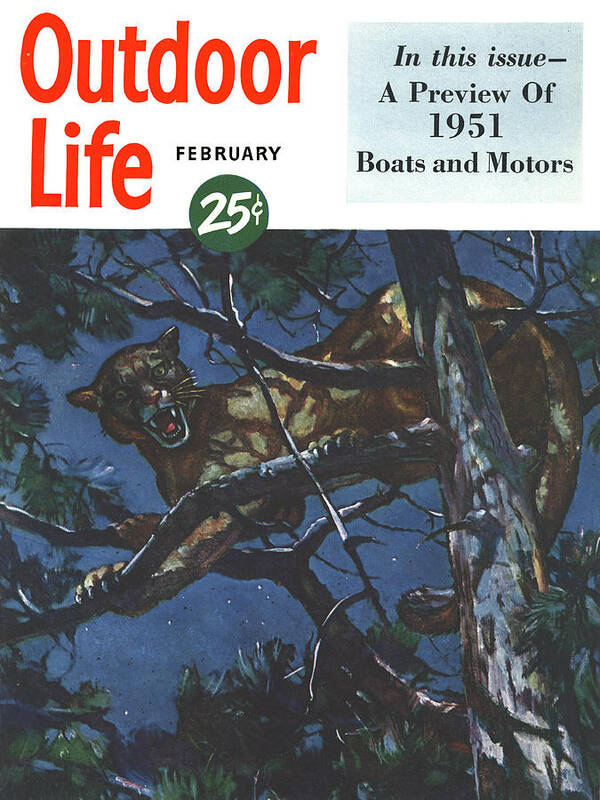
The light was a little better under this tree and I had a clearer view of the lion. I aimed a lung shot that jolted her off her perch and she fell, turning end over end and clawing the air. She landed in a gulley and was under a log in less time than it takes to tell it. Now there was the devil to pay.
Prince broke away from Charlie again and all three dogs dived under the log after the cougar. We got hold of them and dragged them out, but as often as we pulled two off, the third eluded us and went back into the fight. The cat was spitting and growling, the dogs were snarling and baying, and it was so dark under the log we couldn’t tell which was which.
Twice Charlie got all three dogs off long enough for me to drive a shot under the log, but I didn’t hit anything. Then I had a third chance and there was a rasping snarl from the cougar that gradually died away. When the dogs went in again they met no resistance. We let them worry the cougar for a minute or two to make sure, then got down on our knees and pulled the dead lion out. She was bigger than the first one we had killed, weighing about 90 pounds. We concluded they were a mother-and-son hunting team.
It was dark now, except for the stars and the reflected glow cast by the light fall of snow on the ground. I found dry matches and a candle in my pack and we debated lighting a fire to skin the lion by, but finally decided against it. It would be easier to carry her out than to take her pelt off with firelight the only illumination.
We started down off the ridge, dragging and carrying her, lifting her over logs and windfalls: It was slow, hard work until we broke out of the under brush onto an old trail. We hadn’t followed it more than 300 yards when the dogs set up a sudden clamor just ahead. They’d found a fresh deer kill, where a cougar had been feeding. There was too little snow for us to be sure, but we decided later that we’d surprised him on the kill and driven him off. The cougar scent was smoking hot, and the dogs opened on his trail with all stops out. Our efforts to call them off did no good.
“You’d think they’d had enough,” Charlie grumbled as we listened to their eager bawling fade. “Three lions in one day! We need this one like a salmon needs two heads.”
We skidded our dead cougar down to the pick-up, drove home for a hurried supper, then came back and parked the truck where we’d last heard the dogs. Faint and far off, we could hear them barking tree again.
But we’d been guilty of a bad over sight. Expecting to find the dogs completely played out and waiting for us at the end of the road, we’d brought no rifle!
We were too tired now to make another trip back to town, and we’d both had all the after-dark cougar hunting we wanted for one day. It took us only a minute to decide to call the dogs off. “We can come back in the morning and kill this cat by daylight,” I reminded Charlie.
We didn’t know then that we’d have other fish to fry the next day. When we got back to my house, toward midnight, we found Howard Sackett, a logger from the Sitkum area east of Forks, waiting for us with word that he’d found the tracks of a big cougar along the Sitkum River late that afternoon. Did we want to take a crack at it?
We chewed on that one for a few minutes. There was no telling whether we could find and jump the Sitkum cat, and we had a fairly sure bet in the one the dogs had left in the tree. But in the end the long shot won out.
“Let’s go to Sitkum,” Charlie argued. “That lion we left on Maxfield Creek has a fresh kill to feed on and will likely hang around a day or two. The other one may leave the country.”
So it was settled, and Sackett agreed to meet us on the logging road above the Sitkum River the next morning.
We left home at sunup and drove 30 miles east. The country was higher here. There was a foot of snow on the ground and trailing conditions were perfect. Sackett showed us where the lion had crossed the road, going up the mountain, and we parked the pick-up and took the track.
Less than a mile above the road, the dogs put the cougar up from his daytime bed. They drove him at a fast clip and he made a short circle and came past us only 100 feet away, in timber so thick we saw neither lion nor dogs. Just below us he climbed.
We did things the routine way this time, catching the dogs and getting ropes on them. My first shot belted the cougar out of his fork as if lightning had hit him. He didn’t kick after he dropped. The whole hunt was over in an hour after we left the pick-up.
“This makes up for yesterday,” I told Charlie while we were skidding our cat down the mountain to the road. “We’ll be home in time for lunch.”
But I bragged too soon. At the truck we found Sackett again, waiting to tell us that a second cougar had crossed the road a couple of miles farther on.
We were there in 10 minutes. This cat had gone down toward the river, and from the track we figured he was bigger than any of the three we had killed so far.
A short distance below the road we drove him off a kill. He had pulled down a yearling elk that weighed about 250 pounds and was feeding when we came on him. The dogs had exactly what they wanted now, and they were out of hearing in five minutes.
The cat headed for thick stuff down along the bottoms, but the hounds made things too hot for him and he changed his plans. It’s been my experience that a lion prefers to run uphill if he can. Maybe he thinks his chances of eluding the dogs are better that way, or maybe he just prefers high country in a pinch for the rock ledges, caves, and other places of shelter it offers. Anyway, this fellow turned uphill toward us and from their bawling we knew the dogs were stepping on his heels.
Listening to dogs drive a lion straight at you builds up your boiler pressure fast, and that’s the way it was now. Prince, Lu, and Jim came on, louder and nearer minute by minute. Then, 50 yards down the ridge, we heard a sudden loud scratching of claws on bark, and almost in the same instant the dogs were barking treed.
We tied them again and I dropped the cat dead. He was a good-size male, about 130 pounds, and it was uphill all the way to the road this time. We decided that was too much cat to drag out, so we stripped his pelt off and stuffed it into my pack. The walking was tough in the snow, and the sun was down when we got back to the pick-up. But we were plenty satisfied.
Read Next: I Was the Youngest Duck Poacher in Saskatchewan
In two days we had eliminated four lions. Washington pays a $75 bounty on ’em, so we’d made some money. More important, we’d ended the careers of four relentless killers, all young ones with a long life ahead. I figure Charlie and I saved more deer and elk in those two days than the whole town of Forks will kill by hunting in the next dozen years.
We went back to Maxfield Creek before the week was over and clobbered the cougar we left that night when we called the dogs away from the tree, too, but that’s another story.
The post The Game Warden Asked Us to Track One Lion. We Found Four in Two Days appeared first on Outdoor Life.
Source: https://www.outdoorlife.com/hunting/washington-state-cougar-bounty-hunter/


